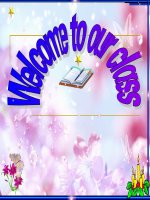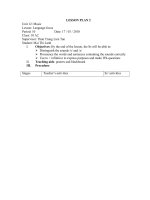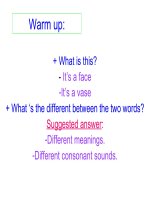Unit 13 FILMS AND CINEMA (Language focus - attitudinal adjectives)
Bạn đang xem bản rút gọn của tài liệu. Xem và tải ngay bản đầy đủ của tài liệu tại đây (116.6 KB, 4 trang )
UNIT 13 FILMS AND CINEMA
Lesson: Language focus
(Time allotted 45 minutes)
I. Aims: By the end of the lesson, Ss will be able to difference two sounds
/f/ and /v/
How to use adjectives of attitude ending in “ed” and “ing”
II. Teaching aids: Textbook, posters, pictures…
III. PROCEDURE
1. Warm – up (5’): Ice breaker:
T goes to the class and says,” good afternoon class” (Ss: “good afternoon T”)
T asks Ss “ok, how are you today?” (Ss: “fine”).
T says “Fine”, “Very good”.
T asks Ss to take a sheet of paper and put it in front of his/her mouth.
T asks the whole class to read aloud the word “fine”.
T asks Ss what happened to the sheet of paper when they read the word (the
sheet of paper vibrates much).
T points at the vase of flower and says: “this is vase of flower”.
T asks the whole class to read aloud the word “vase”
T asks Ss what happened to the sheet of paper when they read the word (the
sheet of paper vibrates less).
T asks Ss to take some words including the sounds “f” and some words
including the sound “v”.
T calls some Ss to read aloud the words.
T gives the comments when read and asks Ss to practice at home.
2. Lead in (1’):
T asks Ss to say some attitudinal adjectives they have learned or they know(
exciting, bored…)
T says ok, today we are going to learn how to use the attitudinal adjectives.
3. Presentation (15’):
A. Vocabulary (6’):
- To bore (v): làm buồn.
+ Explanation technique.
+ T gives the word.
+ T read the word two times.
+ T asks Ss to read chorally and indiviually.
- To embarrass (v): làm ngượng nghịu, lúng túng.
Explanation technique.
- To horrify (v): làm khiếp sợ.
Explanation technique.
- To irritate (v): làm phát cáu
Explanation technique.
- To surprise (v) : làm ngạc nhiên.
Explanation technique.
B. Checking Vocabulary (1’): Rub out and remember
C. Grammar (8’):
T shows on the poster a short conversation.
S: Tam, what do you think about this film?
T: The film is very interesting.
S: So you are interested in the film.
T: Sure.
S: ……………….
T asks Ss:
“Who can tell me the difference of the word “interest” in the two sentences?”
(Answer: the one ends in “ing” and the other ends in “ed”)
T asks Ss to give the reason why two sentences have the difference.(answer:
subject of the first sentence is a thing – film, the subject of the second sentence
is a person – Tam).
T concludes:
Form An adjective + “-ed” An adjective + “-ing”
Meaning Passive meaning Active meaning
Usage
- It can describe someone or
something that receives an
action.
- It often describes a feeling or a
condition.
- It describes someone or
something that does an action.
Examples He was very bored with his job His job was very boring
4. Pracice:( 13’):
A. Exercise 1 (5’): write the adjectival form.
T writes on the BB the following verbs.
1. Bore
2. Embarrass
3. Horrify
4. Irritate
5. Surprise
T asks Ss to write the adjectival form of the verbs.
For example:
Excite → excited/ exciting
T asks Ss to work individually to do the task in three minutes.
After two minutes, T calls some Ss to go to the BB to do the task.
T gives feedbacks and corrects the mistakes if necessary.
Key:
1. Boring / Bored
2. Embarrassing / Embarrassed.
3. Horrifying / Horrified.
4. Irritating / Irritated.
5. Surprising / Surprised.
B. Exercise 2 (8’): Complete the sentences
T asks Ss work individually to do the exercise 2 in page 140 in five
minutes.
After Ss finish the exercise, T asks Ss to exchange to correct the mistake if
necessary.
T calls some Ss to go to the BB to do the exercise.
T gives the feedbacks and corrects the mistakes.
Key:
1. a. Depressing
b. Depressed.
2. a. Interested.
b. Interesting.
3. a. Boring.
b. Bored.
4. a. Excited.
b. Exciting.
5. a. Exhausting.
b. Exhausted
5. Production (8’): Game : noughts and crosses
Giving instructions:
- T divides the class into two teams (each team must chose a leader).
- One team names nought and the other team names cross.
- T will give nine adjectives ending in “ed” or “ing” and asks Ss to make
a sentence with each adjective in 30 seconds per one sentence.
- If the team makes a right sentence in time, T will stick a nought (if
nought team is right) or a cross (if cross team is right) on the table and the team
have right to continue the game.
- If the team cannot give the answer, other will take turns to play.
- The team who has three noughts or three crosses in a line first will be
the winner.
- To begin the game, the leader of each team will do a hammer and
scissors. The winner will play first.
Checking Instructions:
- What you have to do first?
- How much time do you have to make a sentence?
The adjectives:
1. Interesting.
2. Interested
3. Bored.
4. Boring.
5. Excited.
6. Exciting
7. Surprised
8. Surprising.
9. Irritated.
6. Evaluation and homework(3’)
- Learn the vocabulary Ss have studied.
- From the adjectives in exercise 1, T asks Ss to make the sentences using
the adjectives.
For example: Boring / Bored
“ The film was so boring. It made Nam feel bored.”
- T gives some comments:
+ Encourage Ss taking part in the lesson actively and remind Ss to be
more actively and confidently.
(If there is enough time, T gives a sentence :
“He was so boring / bored”
T asks Ss to choose the word “ boring” or “ bored” (answer: two
words can be accepted).
T gives feedbacks and asks Ss to note some special cases when using
the adjectives ending in “ed” or “ing”)









